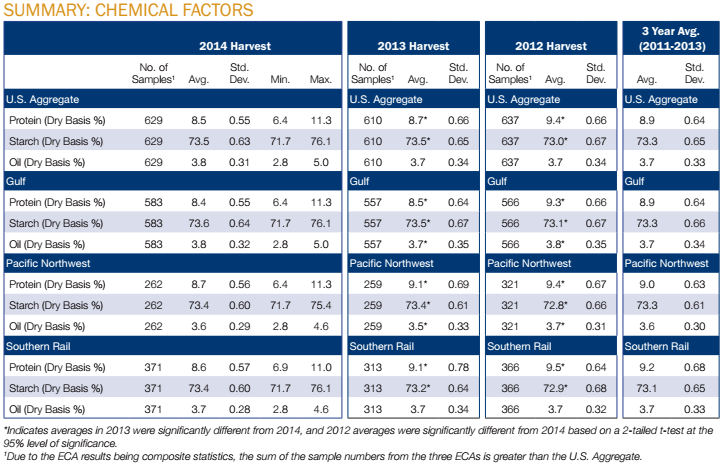C. Chemical Composition
Chemical composition of corn is important because the components of protein, starch and oil are of significant interest to end users. The chemical composition attributes are not grade factors. However, they provide additional information related to nutritional value for livestock and poultry feeding, for wet milling uses, and other processing uses of corn. Unlike many physical attributes, chemical composition values are not expected to change significantly during storage or transport.
SUMMARY: CHEMICAL COMPOSITION
- The lower U.S. Aggregate average protein concentration in 2014 (8.5% dry basis) compared to 3YA (8.9%) is likely attributable to higher yields in 2014 than in any of the previous three years. During the 2014 growing season, available nitrogen was distributed over more metric tons of corn per hectare (or more bushels per acre), causing protein concentration to be lower than in 2013 (8.7%) and the drought year (2012 with 9.4% protein).
- U.S. Aggregate starch average concentration was higher in 2014 (73.5% dry basis) than 3YA (73.3%). The higher starch indicates good kernel filling that should be desirable for corn wet milling.
- U.S. Aggregate oil average concentration in 2014 (3.8% dry basis) was higher than in 2013, 2012, and 3YA (3.7% for each).
- Chemical composition was more uniform in 2014 than in the previous two years (based on lower standard deviations for protein, starch and oil).
- Among ECAs in 2014, the Gulf had lowest protein (8.4%), highest starch (73.6%), and highest oil (3.8%). In comparing 3YA among ECAs, the Gulf again had lowest protein (8.9%), and it tied for highest starch with Pacific Northwest (73.3%).
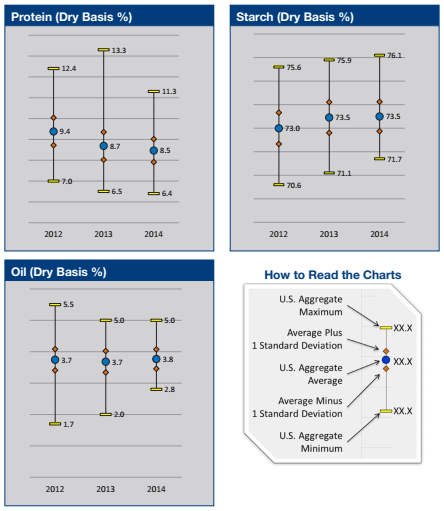
1. Protein
Protein is very important for poultry and livestock feeding. It supplies essential sulfur-containing amino acids and helps to improve feed conversion efficiency. Protein is usually inversely related to starch concentration. Results are reported on a dry basis.
RESULTS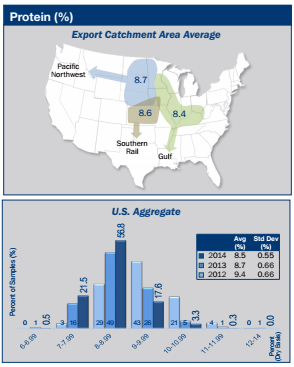
- In 2014, U.S. Aggregate protein concentration averaged 8.5%, which was significantly lower than 8.7% in 2013, 9.4% in 2012, and 8.9% for 3YA.
- U.S. Aggregate protein standard deviation in 2014 (0.55%) was lower than in 2013 (0.66%), in 2012 (0.66%) and for 3YA (0.64%).
- Protein concentration range was lower in 2014 (6.4 to 11.3%) than in 2013 (6.5 to 13.3%) and in 2012 (7.0 to 12.4%).
- Protein concentration in 2014 was distributed with 22.0% below 8.0%, 56.8% between 8.0% and 8.99%, and 21.2% at or above 9.0%. The protein distribution in 2014 shows a lower percentage of samples with high levels of protein than in 2013 or 2012.
- Protein concentration averages for Gulf, Pacific Northwest, and Southern Rail ECAs were 8.4%, 8.7%, and 8.6%, respectively. The Gulf ECA had the lowest protein for 2014, 2013, 2012 and 3YA.
- Over the past four crop years, 11 of the 12 surveyed states have shown a negative relationship between average state corn yield and average state protein concentration. In general, when their average yield has gone up, average protein concentration has gone down.
2. Starch
Starch is an important factor for corn used by wet millers and dry-grind ethanol manufacturers. High starch concentration is often indicative of good kernel maturation/filling conditions and reasonably moderate kernel densities. Starch is usually inversely related to protein concentration. Results are reported on a dry basis.
RESULTS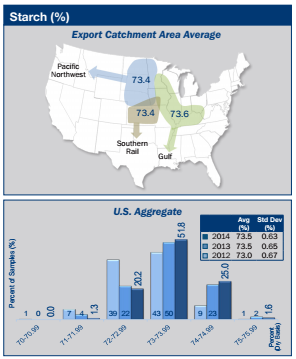
- U.S. Aggregate starch concentration averaged 73.5% in 2014, same as 73.5% in 2013, significantly higher than 73.0% in 2012 and above 73.3% for 3YA.
- U.S. Aggregate starch standard deviation in 2014 (0.63%) was lower than in 2013 (0.65%), in 2012 (0.67%) and for 3YA (0.65%).
- Starch concentration range was lower in 2014 (71.7 to 76.1%) than in 2013 (71.1 to 75.9%) and in 2012 (70.6 to 75.6%).
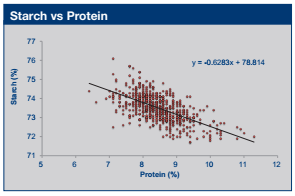
- Starch concentration in 2014 was distributed with 21.5% between 70.0 and 72.99%, 51.8% between 73.0 and 73.99%, and 26.6% equal to or greater than 74.0%, and was similar to the 2013 distribution.
- Starch concentration averages for the Gulf, Pacific Northwest, and Southern Rail ECAs were 73.6%, 73.4% and 73.4%, respectively. Starch concentration averages were highest in the Gulf ECA in 2014, 2013 and 2012. Thus, the Gulf ECA had highest starch and lowest protein in each of the last three years.
- Since starch and protein are the two largest components in corn, when the percentage of one goes up the other usually goes down. This relationship is illustrated in the adjacent figure showing a weak but negative correlation (-0.61) between starch and protein.
3. Oil
Oil is an essential component of poultry and livestock rations. It serves as an energy source, enables fat-soluble vitamins to be utilized, and provides certain essential fatty acids. Oil is also an important co-product of corn wet and dry milling. Results are reported on a dry basis.
RESULTS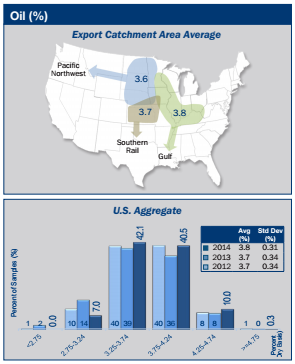
- U.S. Aggregate oil concentration averaged 3.8% in 2014, higher than 3.7% in 2013 and 2012 and for 3YA. U.S. Aggregate oil standard deviation in 2014 (0.31%) was lower than in 2013 and 2012 (0.34% both years) and for 3YA (0.33%).
- Oil concentration ranged from 2.8 to 5.0% in 2014, 2.0 to 5.0% in 2013, and 1.7 to 5.5% in 2012. Oil concentration in 2014 was distributed with 49.1% of the samples at 3.74% or lower, 40.5% of samples at 3.75% to 4.24% and 10.3% at 4.25% and higher. The distribution shows more samples had higher oil levels than in 2013 or 2012.
- Oil concentration averages for Gulf, Pacific Northwest, and Southern Rail ECAs were 3.8%, 3.6% and 3.7%, respectively. Oil concentration averages were higher for the Gulf and Southern Rail ECAs than for the Pacific Northwest for 2014, 2013 and 3YA.
